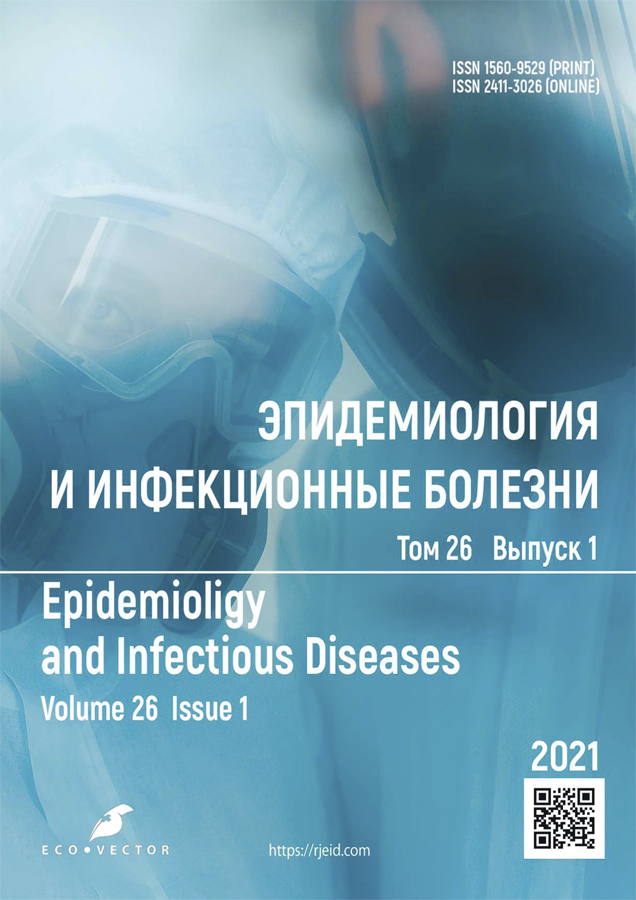Clinical efficacy of assisted intranasal ventilation after polysegmental pneumonia caused by the SARS-CoV-2 virus
- 作者: Nikiforov V.V.1, Stebletcov S.V.2,3, Maslennikova O.M.2, Zakirova A.S.2, Pashovkina O.V.3
-
隶属关系:
- The Russian National Research Medical University named after N.I. Pirogov
- Central State Medical Academy of Department of Presidential Affairs
- Clinical Hospital № 1 of Department of Presidential Affairs
- 期: 卷 26, 编号 1 (2021)
- 页面: 15-22
- 栏目: Original study articles
- ##submission.dateSubmitted##: 18.02.2022
- ##submission.dateAccepted##: 24.02.2022
- ##submission.datePublished##: 01.01.2021
- URL: https://rjeid.com/1560-9529/article/view/101092
- DOI: https://doi.org/10.17816/EID101092
- ID: 101092
如何引用文章
详细
BACKGROUND: The development of ways of rehabilitation of patients after polysegmental viral pneumonia that enable the collapsed alveoli being transferred to a ventilated and actively perfused state is certainly relevant. In this regard, non-invasive respiratory support can be considered as a reasonable additional method of treatment for these patients.
AIMS: Assess the feasibility of non-invasive assisted ventilation of the lungs after suffering polysegmental pneumonia caused by the SARS-CoV-2 virus.
MATERIALS AND METHODS: The study included 40 patients after bilateral polysegmental pneumonia caused by the SARS-CoV-2 virus. The first group of patients (21 people), in addition to the standard treatment, underwent non-invasive assisted intranasal ventilation in the BiPAP mode with a final expiratory pressure of 4–8 cm of water. Art. 60 minutes three times a day for 10–12 days. The second group (19 people) did not receive ventilation benefits. Before the start of therapy and at the end of the course, spirometry, computed tomography of the chest organs were performed with the calculation of the volume of the affected lung tissue according to the Thoracic VCAR program.
RESULTS: Upon completion of the course of treatment and rehabilitation measures in patients of the first group, the following was observed: a decrease in atelectatic changes and pneumofibrosis, an increase in the volume of ventilated areas of the lungs, the volume of the affected lung tissue according to computed tomography significantly decreased (on average, up to 26±9.8%; p <0.05). There was a significant improvement in the indicators of spirometry in the first group. The increase in the volume of forced exhalation in one second was 25–32%, while vital capacity of the lungs was 27–31%. When evaluating long-term pulse oximetry, the average saturation at night in these patients increased from 91.2±2.1 to 96.4±1.8 (p <0.05). Clinical improvement in patients of the first group led to a decrease in bed-days to an average of 15.4, while in patients of the second group it averaged 23.4 days.
CONCLUSION: The use of assisted intranasal ventilation restores the ventilation-perfusion ratio, which is confirmed by a significant improvement in clinical and instrumental parameters.
全文:
作者简介
Vladimir Nikiforov
The Russian National Research Medical University named after N.I. Pirogov
Email: v.v.nikiforov@gmail.com
ORCID iD: 0000-0002-2205-9674
SPIN 代码: 9044-5289
MD, Dr. Sci. (Med), Professor
俄罗斯联邦, MoscowSergey Stebletcov
Central State Medical Academy of Department of Presidential Affairs; Clinical Hospital № 1 of Department of Presidential Affairs
Email: 7708353@mail.ru
ORCID iD: 0000-0002-5309-3330
SPIN 代码: 6440-9479
MD, Cand. Sci. (Med.), Associate Professor
Moscow; MoscowOlga Maslennikova
Central State Medical Academy of Department of Presidential Affairs
Email: o.m.maslennikova@gmail.com
ORCID iD: 0000-0001-9599-7381
SPIN 代码: 5516-9979
MD, Dr. Sci. (Med)
俄罗斯联邦, MoscowAlina Zakirova
Central State Medical Academy of Department of Presidential Affairs
Email: zakirova.a.s.143@gmail.com
ORCID iD: 0000-0001-7214-4845
SPIN 代码: 4495-5070
俄罗斯联邦, Moscow
Olga Pashovkina
Clinical Hospital № 1 of Department of Presidential Affairs
编辑信件的主要联系方式.
Email: dr.pashovkina@mail.ru
ORCID iD: 0000-0001-6955-4595
SPIN 代码: 3448-9764
俄罗斯联邦, Moscow
参考
- Temporary guidelines «Prevention, diagnosis and treatment of new coronavirus infection (COVID-19). Version 8.1 (01.10.2020)» (approved by the Ministry of Health of Russia). (In Russ). Available from: https://base.garant.ru/74710416/. Accessed: 15.10.2020.
- Decree of the Government of the Russian Federation No. 66 dated 31.01.2020 “On Amendments to the list of Diseases that pose a danger to others”. (In Russ). Available from: https://base.garant.ru/ 73492109/. Accessed: 15.10.2020.
- Zairatyants OV, Samsonova MV, Mikhaleva LM, et al. Pathological anatomy with CОVID-19: Atlas. Ed. by O.V. Zairatyants. Moscow, 2020. 142 p. (In Russ).
- Shchelkanov MYu, Kolobukhina LV, Burgasova OA, et al. COVID-19: etiology, clinic, treatment. Infection and Immunity. 2020;10(3):421–445. (In Russ).
- Borodulina EA, Shirobokov YE, Gladunova EP, Kudlay DA. A new approach to the choice of respiratory support method in pulmonology. Modern Technologies in Medicine. 2018;10(2):140–146. (In Russ). doi: 10.17691/stm2018.10.2.16
- He H, Sun B, Liang L, et al. A multicenter RCT of noninvasive ventilation in pneumonia-induced early mild acute respiratory distress syndrome. Crit Care. 2019;23(1):300. doi: 10.1186/s13054-019-2575-6
- Avdeev SN, Tsareva NA, Merzhoeva ZM, et al. Practical recommendations on oxygen therapy and respiratory support for patients with COVID-19 at the resuscitation stage. Pulmonology. 2020;30(2):151–163. (In Russ).
- Temporary guidelines “Medical rehabilitation for new coronavirus infection (COVID-19). Version 2 (31.07.2020)” (approved by the Ministry of Health of Russia). (In Russ). Available from: https://base.garant.ru/74448610/. Accessed: 15.10.2020.
- Meshcheryakova NN, Belevsky AS, Kuleshov AV. Pulmonary rehabilitation of patients who have undergone COVID-19 coronavirus infection. Pulmonology. 2020;30(5):715–722. (In Russ).
- Grippi MA. Pathophysiology of the lungs. Transl. from the English by Yu.M. Shapkaits, ed. by Yu.V. Natochin. 2nd ed. Moscow; Saint Petersburg: BINOM, Nevskii Dialekt; 1999. 344 p. (In Russ).
- Kumar V, Abbas AK, Fausto N, Aster DK. Robbins and Cotran pathologic basis of disease. Trans. from English. Moscow: Logosfera; 2016. 1740 p. (In Russ).
补充文件









